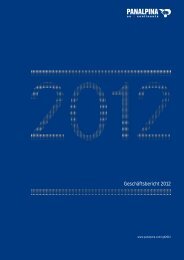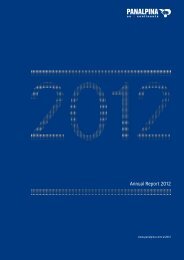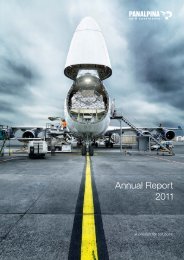Annual Report 2010 (PDF, 5.2MB) - Panalpina Annual Report 2012
Annual Report 2010 (PDF, 5.2MB) - Panalpina Annual Report 2012
Annual Report 2010 (PDF, 5.2MB) - Panalpina Annual Report 2012
You also want an ePaper? Increase the reach of your titles
YUMPU automatically turns print PDFs into web optimized ePapers that Google loves.
Consolidated and <strong>Annual</strong> Financial Statements <strong>2010</strong><br />
116<br />
<strong>2010</strong> (in thousand CHF) Level 1 Level 2 Level 3 Total<br />
Available-for-sale financial assets 0 1,074 14,228 15,302<br />
Financial assets at fair value through profit or loss held for trading 691 125 0 816<br />
Derivative financial assets 0 20,454 0 20,454<br />
Available-for-sale financial assets at cost 323<br />
Total 36,895<br />
Derivative financial liabilities 0 5,532 0 5,532<br />
Total 5,532<br />
2009 (in thousand CHF) Level 1 Level 2 Level 3 Total<br />
Available-for-sale financial assets 252 1,068 15,963 17,283<br />
Financial assets at fair value through profit or loss held for trading 463 155 0 618<br />
Derivative financial assets 0 11,286 0 11,286<br />
Available-for-sale financial assets at cost 511<br />
Total 29,698<br />
Derivative financial liabilities 0 2,233 0 2,233<br />
Total 2,233<br />
The fair value of financial instruments traded in active markets is based on quoted market prices at the statement of financial position<br />
date. A market is regarded as active if quoted prices are readily and regularly available from an exchange, dealer, broker, industry group,<br />
pricing service or regulatory agency, and those prices represent actual and regularly occurring market transactions on an arm’s-length<br />
basis. The quoted market price used for financial assets held by the Group is the current bid price. These instruments are included in<br />
level 1.<br />
The fair value of financial instruments that are not traded in an active market (for example, over-the-counter derivatives) is determined<br />
by using valuation techniques. These valuation techniques maximize the use of observable market data where it is available and rely as little<br />
as possible on entity-specific estimates. If all significant inputs required to fair-value an instrument are observable, the instrument<br />
is included in level 2.<br />
If one or more of the significant inputs is not based on observable market data, the instrument is included in level 3.<br />
The Group used the discounted cash flow method to determine the fair value of level 3 financial instruments.<br />
The following table presents the changes in level 3 instruments for the year ended 31 December <strong>2010</strong>:<br />
in thousand CHF<br />
Available-for-sale<br />
financial assets<br />
Total<br />
Balance on 1 January 15,963 15,963<br />
Fair value adjustments in the statement of comprehensive income (1,735) (1,735)<br />
Balance on 31 December 14,228 14,228<br />
Total gains or losses for the period included in the statement of comprehensive income for assets<br />
held at the end of the reporting period (1,735) (1,735)<br />
Neither in <strong>2010</strong> nor in 2009 did the Group transfer financial instruments into another level.<br />
Market risk<br />
Market risk is the risk that the fair value of future cash flows of a financial instrument will fluctuate due to changes in market price. Market<br />
prices entail three types of risk: foreign currency risk, interest rate risk and other price risk such as equity risk.<br />
The Group’s activities expose it primarily to financial risk due to changes in foreign currency exchange rates.<br />
<strong>Panalpina</strong> <strong>Annual</strong> <strong>Report</strong> <strong>2010</strong>






